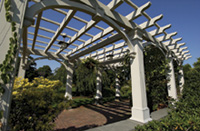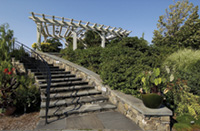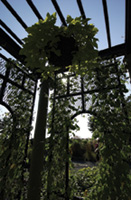The Nikon AF-S DX Zoom 12-24mm f/4G ED-IF Lens
Digital Wide Angle Photography
Like modern automobile engines, most digital cameras equipped with interchangeable lenses seem to have most of their power or torque at the high end of the focal length scale. In digital SLRs with smaller than full-frame sensors, your 300mm might be a 450mm and the 500mm a 750mm lens, all without any converters or tele-extenders. For outdoor and wildlife photographers this has been a blessing. However, on the lower end of the scale digital photographers have been shortchanged when it came to true wide angle lenses, as when a 20mm "film" lens comes out to around 30mm focal length. And even if you have the means to own one of Nikon's 14mm lenses, your angle of attack is still only 20mm, no matter how you cut it on the image plane. |
|||
For Nikon owners this dilemma
may be solved. Part of the DX series, the 12-24mm f/4 lens is much smaller
than most of its counterparts of the same focal length(s). As with the
DX series the lens is designed to be used on digital cameras only, so
don't buy this lens with the hope of getting multiple use out of
it on both film and digital cameras. |
|||
Construction wise, Nikon started
with a polycarbonate lens barrel for durability and it is finished in
a matte black to match current D-series bodies. From there you have twin
rubber rings for both zoom and manual focusing control. The lens incorporates
the AF-S Silent Wave motor for near instant acquisition of your subject
and included is the M/A (Manual/Automatic) or M (Manual) slide switches
on the left side of the lens barrel. |
|||
With a 2x zoom ratio, Nikon
chose to include 11 elements in seven groups to bring out the best on
your sensor. Two of the elements are ED (Extra Low Dispersion) glass and
three are Aspherical. Apparently Nikon is finding good use of integrating
premium glass in all of their lenses to help keep color fringing and chromatic
aberrations at a minimum. |
|||
Other specs of note include
seven rounded aperture blades, to make close to subject out of focus backgrounds
more natural; a "D" chip for precise exposure of ambient light
or flash fill-in; and a "G" configuration, which means that
all f/stops are controlled by the command control on the front of your
Nikon digital camera. Internal Focus (IF) places more balance with the
lens in your hand as it does not expand or contract as you rotate the
focusing ring. Finally, when using or storing the lens with the lens hood
on, the new squeeze type of lens cap is now standard equipment and comes
with the lens at no charge. |
|||
Nice specs, but how does this
DX lens perform? Setting up both my F100 (film camera) with a 17-35mm
zoom and my D1X (digital camera) with the 12-24mm DX the following observations
were noted. Since both cameras have a viewfinder of 96 percent it would
be an even match when comparing the angle of view of both. In photo terms
that we all understand, placing the DX lens at 12mm and the 17-35mm at
20mm created the same image borders and angle of view. So, in effect,
we use the same approximate angle of view (12mm digital = 20mm film),
as before but with a lens design we never had previous to the DX series.
Setting the DX on 18mm yields the same angle of view as we are used to
on a common 28mm lens. The thing to keep in mind is that you should use
the lens as is and not keep comparing it to a film-type lens, because
in truth you are getting a 99Þ field of view on your Nikon D-series
camera at 12mm. |
|||
Out in the field I was duly
impressed with this new offering. Coming back from New York state in somewhat
unseasonable weather I stopped for a break at Stockbridge, Massachusetts,
which is the home of famed painter Norman Rockwell. The results were crisp
and free from flare, thanks to Nikon's Super Integrated Coating,
and very sharp corner to corner. Later, in other informal sessions, the
lens was quick on the uptake thanks to Silent Wave technology. Any photographer
who has this 12-24mm DX in his camera bag is certainly on his or her way
to getting the most out of a digital camera. |
|||
Technical Specifications |
- Log in or register to post comments









































